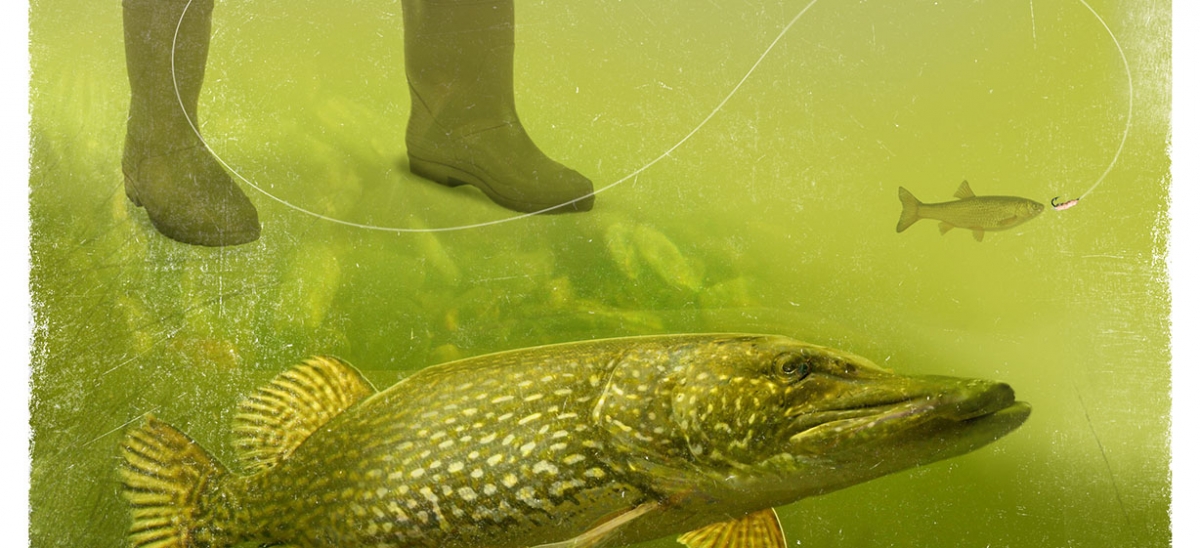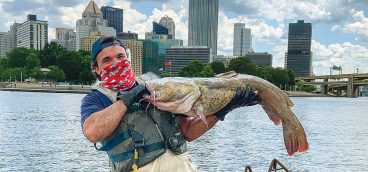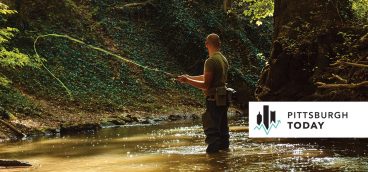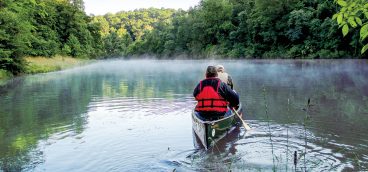
Dunbar creek runs into the Youghiogheny River just north of South Connellsville in Fayette County. Vestiges of the interurban streetcar lines are all over. A massive stone arch that was once part of a bridge crossing the Dunbar Creek valley stands like an ancient Roman aqueduct by the coke oven complex near Wheeler.
I grew up walking the few miles through here, from home to the river. And after college, when I was hired as a teacher, I resumed this hajj. Mobility and modified habits made these later trips much easier, but really no more enjoyable.
The mouth of Dunbar Creek drops about three feet along a series of ledges, and a 45-degree bend in the river cuts pockets into the bank under the big maples and sycamores. Through the years, the river has breached the peninsula between the Yough and the creek, each time progressively further up the creek. Soon, this childhood Brigadoon may vanish altogether—maybe in a hurricane that gets caught by Chestnut Ridge while rolling up the Ohio Valley, maybe with a state scar-lift program that tries to absolve the sins of the railroad and the coal industries, though nature has long since covered over, if not healed, those wounds.
As a kid, I caught trout in the top riffles at the mouth of Dunbar and in some eddy pockets, for about 20 yards, all the way down the drop. The river hole just below is called Thirty-foot, but no one remembers why. That bend in the Yough creates a sandbar about 50 yards long here. Since the 1970s, with some pollution sources stopped, the shallows on the South Connellsville side have always attracted smallmouth bass among stumps, rocks and cut-stone boulders. Decent yellow perch sometimes hit at the north side drop-off, just after dark. But these have dwindled, prey to the predator fish stocked by the state Fish Commission. Few people fish here, because of the long walk and sometimes rough wading.
Above the rapids, in the river, a long, slow hole beside the railroad and an old streetcar-line icehouse has always held a variety of fish. I was in a dilemma once, as a young teenaged truant, on what to do with a bright-red-sided, 19-inch rainbow trout that hit a spinner when I was supposed to be at First Friday Mass. I decided to keep the fish and take my lumps when I got home. Dad, ever the pragmatist, made me promise never to cut school again, and he would forgo the lumps. He loved trout, pan-fried in butter.
From there, about three-quarters of a mile upstream, the remnants of the early 20th century West Penn Street Railway’s power dam still create an attractive, roaring hole that’s tough to fish but naturally loaded with lunkers.
This powerhouse dam is about as far south as Pennsylvania’s 1970s musky fingerling planting program went on the Yough River. From the powerhouse, all the way upriver to Yough Lake, the mountains kept the area too uneconomical for much of the Industrial Revolution’s gouging. There was some logging, but most of that was to cut the coal mines’ timbers and roof braces. Only in recent years, with the skyrocketing cost of building materials at home and the growth of a local-lumber global export trade, has logging become cost-effective. Luckily, the Western Pennsylvania Conservancy, the Sierra Club and Trout Unlimited have caught the attention of lawmakers who might otherwise be tempted to allow development. Pennsylvania has protected this gem and bolstered some of the more accessible parts with regular, judicious trout stocking, attracting fishermen and tourist dollars without much damage.
Throughout the summers of my youth, I caught a few nice kamikaze game fish all along these stretches of river and creek. When game fish refused to cooperate, a #12 pink or salmon Honey Bug nymph on a fly rod on the last hole on Dunbar Creek always produced 5- to 6-inch, less discerning creek chubs and fallfish. Luckily, these fun-to-catch fish weren’t too spooky, because with so many opportunities for snags, the down time would be expensive.
As the years passed, I became a teacher, and the first weekend of May became the opening of walleye and pike season. It was something to plan for, as the Yough fishery became more enticing and productive. Early one autumn, I discovered new holes below the low-head powerhouse dam, where a hidden channel with big rocks attracted the big predator fish. They would lie in ambush and flash into deeper water to eat their prizes. The secret would be having large, live minnows fished deep, slowly, from a shelf in the wall.
This discovery kept me counting the days until spring. Trout season would open on a mid-April Saturday, but I had projects to grade. Then when the projects were finished came the teacher’s annual spring bout of sore throat, sinus drainage and chest cold, Pennsylvania-style.
At last, that final Friday before the opening of walleye and pike season was at hand. I packed my fly gear, a change of clothes (I’d metamorphose in the school locker room), and a big plastic bucket with a screened lid. This time I’d thought of everything. I packed a small, two-wheel dolly for the big bucket and a liner basket to keep the bait fresh until I got home and placed them in a chilly spring on my farm.
All I needed was a few afternoon hours at the mouth of the creek to catch a dozen baitfish before opening day. Saturday morning waited. My uncle’s stout old casting rod and reel were oiled and ready for pike or musky. I’d rigged a dozen pairs of snelled hooks and sinkers to take the baits to the bottom to drift slowly past the baitfish lairs.
Four of my six Friday classes were finishing preparations for SATs the next day, so last-minute coaching on analogies and testing strategies were the order of the day. Other students were working on senior projects. The 2:30 dismissal couldn’t come quickly enough.
The walk from the car to the head of the creek trail was a blur. As usual, I stumbled across the railroad ties. Carrying, instead of wearing, my hip boots was an absolute necessity for crossing the platform down from the bridge; this is no place to be clumsy. The trail is about a half-mile long and fairly clear, but all sorts of briers and multiflora reach in to make the trip interesting if hands are full.
Finally, with boot straps secured, I stepped into the cool stream. Dunbar stumbles over rocky rapids on its long run from the mountains to the river, but it flows mostly through trees, so the spring sun only warms it a little—just enough to set off some hatches.
From the head of a riffle, I roll-casted a shrimp-pink Honey Bug about 15 yards, upstream and across. It only drifted a few feet before a three-inch chub swiped at it. My trigger was a bit off, so I rolled it out again, this time closer to the channel, near some brush. Another chub slapped it and danced on its tail out into the creek. This guy caught himself, as I was still slow and clumsy. I put the mesh basket into the stream in about a foot of water and placed the bright and lively five-inch fish inside.
I waded to the South Connellsville side and started working my way upstream, toward the riffle at the bend at the head of the hole. It flowed into some brush on the Wheeler side—good cover. I decided to take the basket with me, so I strapped it onto my belt and slogged on.
At the top of the pool, 10 yards across the slow riffle, I rolled the bug again; it got some attention. A few more tosses got a hit that I missed, then a good-sized swirl—no luck. A few more casts, and I started to work my way downstream. By the time I got to my starting point, I had caught two more chubs, four and five inches, and missed two more. I had waded in on the Wheeler side, into the first breach of the river up from the mouth. The rocky rapid had a pretty fair volume of water, so I waded carefully. I stopped and rolled a cast upstream, held the rod tip up, and stripped in a few feet of line; the bug sank a little and started to drift down the current. A nice chub grabbed on, and for once, I was ready. It was hooked fairly well. I kept the line tight and lifted the rod a little further. The fish rolled and dove.
Then it struck. As the chub flashed upstream, a long shadow darted out from under some maple roots overhanging the bank, grabbed the chub and shot upstream toward the deeper, tangled hole. I stood straight up, lifted my arms and set the hook, like on the TV shows. The fish darted upstream, then jumped fully out of the water. I stood mesmerized by a long, toothy, green-gold pike falling back on its right side, hooked in the left corner of the mouth—more importantly, away from those teeth.
I was standing shin-deep in water on mossy rocks, and suddenly I found myself sitting, tailbone aching. But I kept the rod tip up and light pressure on the running fish. As it headed toward more roots at the head of the pool, I leaned the rod to the left, away from its run, and lightly palmed the spool of the reel. Somehow this slowed and turned the pike to the left, upstream, toward faster, shallower water.
I struggled to my feet and hurried upstream, arms held high. When I was just behind the fish, it suddenly raced downstream. I stripped line in with my left hand and kept the line tight. The pike shot past me, and I let it take line slowly, now leaning right, away from its lair under the maple. I stumbled and split the plastic bucket with my elbow.
The fish went past the roots, over the rapid and toward the mouth of the creek and the river. I must have looked like I was ‘moonwalking’ as I went through the slimy-rocked rapids. I stumbled to my knees once, but kept my back arched and pressure on my fish.
It swung toward a large rock and shot behind it. Somehow I had the presence of mind to strip in line and walk downstream toward the rock. The pike shot from the rock, left, across the stream and turned back upstream. The fish was fighting the current and my tension on the line, and it started slowly shaking its head, left then right, trying to get its snout into the rocks. But the No. 12 Honey Bug held in the corner of its mouth, the chub long-gone. The fish swam through the rapid past its lair again, but was quickly running out of steam. All the while, I stripped in line as I walked upstream. The side-to-side, upstream shaking slowed and then stopped. I waded forward slowly, reeling in more line.
The half-hour battle left me bruised and bleeding, hip boots full of water, missing glasses, and with a soaked backside covered in mud, muck and algae. I gingerly dragged in the heavy 26-inch northern pike. I slipped my insufficient trout net under it and spirited it, unceremoniously, 10 feet to the slick, rocky bank.
As I caught my breath and the adrenaline subsided (through the taste of my bitten lip), I measured the fish and imagined the sweet taste of lightly grilled pike, new red potatoes and roasted butternut squash.
Then I remembered why I was there in the first place—to catch baitfish. The season opener was tomorrow, Saturday, at 12:01 a.m.—only about six hours away. Laughing pathetically, I put the tired fish back in the water, moving it up and back to fill its gills with air, making sure it recovered. Then it was off. Aside from the bruises and cuts that Dunbar Creek had inflicted, all I had to show for my battle was the image of that pike, because the next morning, I was too tired and sore to get out of bed.





